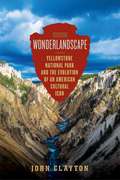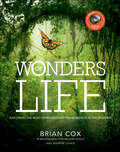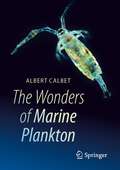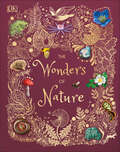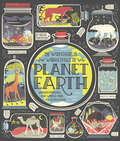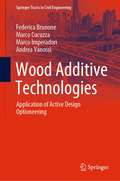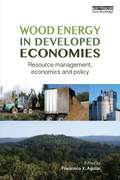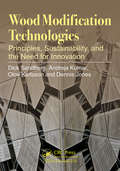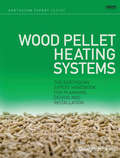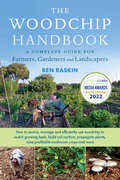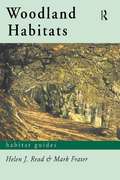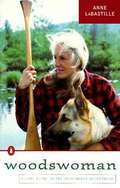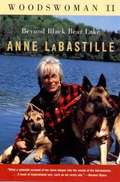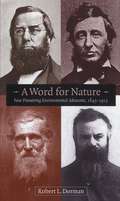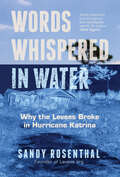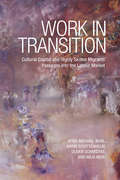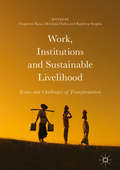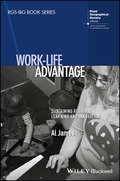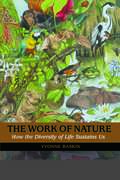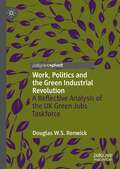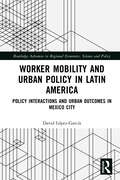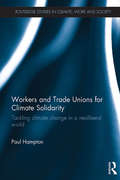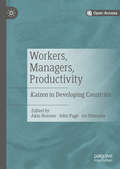- Table View
- List View
Wonderlandscape: A Cultural History Of Yellowstone National Park
by John ClaytonAn evocative blend of history and nature writing that tells the story of Yellowstone’s evolving significance in American culture through the stories of ten iconic figures. Yellowstone is America's premier national park. Today is often a byword for conservation, natural beauty, and a way for everyone to enjoy the great outdoors. But it was not always this way. Wonderlandscape presents a new perspective on Yellowstone, the emotions various natural wonders and attractions evoke, and how this explains the park's relationship to America as a whole. Whether it is artists or naturalists, entrepreneurs or pop-culture icons, each character in the story of Yellowstone ends up reflecting and redefining the park for the values of its era. For example, when Ernest Thompson Seton wanted to observe bears in 1897, his adventures highlighted the way the park transformed from a set of geological oddities to a wildlife sanctuary, reflecting a nation was concerned about disappearing populations of bison and other species. Subsequent eras added Rooseveltian masculinity, democratic patriotism, ecosystem science, and artistic inspiration as core Yellowstone hallmarks. As the National Park system enters its second century, Wonderlandscape allows us to reflect on the values and heritage that Yellowstone alone has come to represent—how it will shape the America's relationship with her land for generations to come.
Wonders of Life: Exploring the Most Extraordinary Phenomenon in the Universe (Wonders Series)
by Brian Cox Andrew CohenIn Wonders of Life: Exploring the Most Extraordinary Force in the Universe, the definitive companion to the Discovery Science Channel series, Professor Brian Cox takes us on an incredible journey to discover the most complex, diverse, and unique force in the universe: life itself.Through his voyage of discovery, international bestselling author Brian Cox explains how the astonishing inventiveness of nature came about and uncovers the milestones in the epic journey from the origin of life to our own lives, with beautiful full-color illustrations throughout. From spectacular fountains of superheated water at the bottom of the Atlantic to the deepest rainforest, Cox seeks out the places where the biggest questions about life may be answered: What is life? Why do we need water? Why does life end?Physicist and professor Brian Cox uncovers the secrets of life in the most unexpected locations and in the most stunning detail in this beautiful full-color volume.
The Wonders of Marine Plankton
by Albert CalbetMarine plankton, despite their tiny size, are crucial for the functioning of marine food webs. It is not just about one organism eating another; when this happens, it helps release the nutrients accumulated within living matter, making them available again for microalgae. Plankton are present in freshwater and in all the seas and oceans on the planet. Moreover, they are responsible for supporting life on Earth and has provided us (on geological timescales) with a significant portion of the oxygen we breathe. In just a small spoonful of seawater, we can find around fifty million viruses, five million bacteria, hundreds of thousands of small unicellular flagellates, thousands of microscopic algae, five heterotrophic ciliates or dinoflagellates, and, with some luck, a small crustacean like copepods. This book aims to bridge the gap between scientific research and the general public, offering a captivating exploration of the fascinating world of marine plankton. Through engaging narratives and visually compelling illustrations, readers will gain insights into the importance of plankton in marine ecosystems, their diverse forms, and the crucial role they play in maintaining our planet's health.
The Wonders of Nature (DK Children's Anthologies)
by Ben HoareUncover awe-inspiring stories behind the natural world with this nature book for curious kids aged 6-8.The world is filled with curious objects such as amazing rocks and minerals, microscopic life, plants, animals and more. The wonders of wildlife are so much bigger than young minds can fathom and there is always more to learn! The Wonders of Nature is a stunning nature encyclopedia for young readers to explore, with reference pages packed with fascinating information, little learners will be captivated as they dive into this collection of 100 remarkableitems from the natural world, from orchids to opals and lichens to lizards and so much more! Each plant, animal, and rock is shown both photographically and illustrated, and children will love poring over the detailed close-up images. The storybook descriptions let you discover the myths and legends surrounding both organisms and gemstones, as well as key facts about their natural history. Find out how the prowling jaguar uses spots to avoid being spotted, why a sticky sundew means big trouble for insects, and what on Earth a radiolarian is. This beautiful treasury lets you find the things that interest you and uncover new favourites along the way. With reference pages packed with information you&’ll go away knowing something you didn&’t before, and you&’ll return time and again. The Wonders of Nature takes you on a tour of our planet through commonplace-but-incredible objects made by nature itself. The engaging storybook-style descriptions and simple text shed a light on the wonders of nature and wildlife, making this book ideal for inquisitive children aged 6-8 who loves to spot things when exploring outside and wants to know more about the wonderful and mysterious natural world.Celebrate your child&’s curiosity as they:- Explore 100 minerals, plants, and animals each with a stunning photographs and illustrations- Reveal fun facts in visual index guides that provide key reference information - Uncover captivating information on the natural history and mythology of a variety of nature&’s wonders This nature encyclopedia for children is the perfect blend of storybook style text with out of this world illustrations which makes it a fantastic nature book for children who are obsessed with wildlife and the natural world. Encourage young readers to go on a journey to explore a world of information, making this the ideal first reference book for kids aged 6-8 to enjoy for hours on end, whether reading with the family or reading alone, this fun fact book also doubles up as the perfect gift for curious kids who love to learn. Explore the vastness of space by uncovering: -Stunning Jacket Detail: gold foil, holographic foil & metallic gold edges-Striking photography & illustrations inside-A beautiful book for the whole family to treasure -A quality gift to be passed down through the generationsMore in the SeriesThe Wonder&’s of Nature is part of the beautiful and informative Anthology series. Complete the series and nurture your child's curiosity as they explore the natural world with Nature&’s Treasures or let them walk with the dinosaurs who ruled the earth before them in Dinosaurs and other Prehistoric Life.
Wonders of the Rain Forest
by Janet CraigDiscusses the animals and plants which give such color and beauty to tropical rain forests and jungles.
The Wondrous Workings of Planet Earth: Understanding Our World and Its Ecosystems
by Rachel IgnotofskyAn illustrated tour of the planet exploring ecosystems large and small, from reefs, deserts, and rainforests to a single drop of water—from the New York Times best-selling author of Women in Science. Making earth science accessible and entertaining through art, maps, and infographics, The Wondrous Workings of Planet Earth explains how our planet works—and how we can protect it—from its diverse ecosystems and their inhabitants, to the levels of ecology, the importance of biodiversity, the cycles of nature, and more. Science- and nature-loving readers of all ages will delight in this utterly charming guide to our amazing home.
Wood Additive Technologies: Application of Active Design Optioneering (Springer Tracts in Civil Engineering)
by Marco Imperadori Federica Brunone Marco Cucuzza Andrea VanossiThe book encodes a vision for the actively sustainable management and development of the built environment by referring to the application of timber-based construction systems as additive solutions for the multi-purpose improvement of existing buildings. It translates this vision into an innovative methodology for the management of the entire building process – from design to production, operation, and maintenance - and the assessment of timber-based construction performances across the whole building life-cycle. This approach is based on a multi-dimensional analysis, which starts from the structure of the Active House (AH) protocol, improved through information-integrated digital environments and multi-criteria evaluation methods, such as BIM and Design Optioneering. During the design stage, indeed, it analyzes and compares different design choices, according to the DO method, until the definition and validation of the “As-Built” step, while in the operational phase, it refers to sensors-retrieved data to show the evolution of the building behaviour, accounting for real users’ interaction, building performances decay and needs of maintenance, defining the digital twin of the building: a real Cognitive Building. Finally, the application of this methodology identifies innovative models of processes, products, and design of wood-based construction technologies, suitable to satisfy the needs of the 2D/3D construction layering for the sustainable transformation of the built environment.
Wood Energy in Developed Economies: Resource Management, Economics and Policy
by Francisco X. AguilarThere has been a recent resurgence of interest in wood energy as part of a sustainable range of renewable energy options. This book addresses the current gap in the energy and public policy literature for a reference book that compiles the most-recent wood energy assessments, and evaluates current and potential future wood energy uses and the role for public policy to foster efficient use of the most-widely consumed renewable energy in the world. It brings together a group of expert authors covering topics from forest management, operations and engineering, to socio-economics and energy policy perspectives. It thus covers practical issues such as silviculture, harvesting, processing, comparative cost estimates, public policy tools and market effects. As such the book provides a comprehensive review of the complex dimensions of wood energy as well as practical guidance for professionals, researchers and advanced students. It will also provide invaluable guidance for economic development agencies, practitioners and policy-makers, when evaluating the impacts of wider wood energy adoption as part of a strategy for sustainable energy generation. The main focus is on industrialised production and developed economies, particularly the USA and Europe.
Wood Modification Technologies: Principles, Sustainability, and the Need for Innovation
by Dick Sandberg Andreja Kutnar Olov Karlsson Dennis JonesThe market for durable products using modified wood has increased substantially during the last few years. This is partly because of the restriction on the use of toxic preservatives due to environmental concerns, and to lower maintenance cost and time. Furthermore, as sustainability becomes a greater concern, the environmental impact of construction and interior materials is factored in planning by considering the whole life cycle and embodied energy of the materials used. Wood is modified to improve its intrinsic properties, enhance the range of applications of timber, and to acquire the form and functionality desired by engineers without calling the environmental friendliness into question. Wood modification processes are at various stages of development, and the challenges faced in scaling up to industrial applications differ. The aim of this book is to put together the key elements of the changes of wood constituents and the related changes in wood properties of modified wood. Further, a selection of the principal technologies implemented in wood modification are presented. This work is intended for researchers, professionals of timber construction, as well as students studying the science of materials, civil engineering and architecture. This work is not exhaustive, but intends to deliver an outline of the scientific disciplines necessary to apprehend the technologies of wood modification and its behavior during treatment, as well as during its use.
Wood Pellet Heating Systems: The Earthscan Expert Handbook on Planning, Design and Installation (Earthscan Expert Ser.)
by Dilwyn JenkinsWood Pellet Heating Systems is a comprehensive handbook covering all aspects of wood pellet heating technology. The use of wood pellets as an alternative heating fuel is already well established in several countries and is becoming widespread as fossil fuel prices continue to rise and awareness of climate change grows. Wood pellets are a carbon-neutral technology, convenient to use, and can easily be integrated into existing central heating systems or used in independent space heaters. This fully-illustrated and easy-to-follow guide shows how wood-pellet heating works, the different types of systems – from small living room stove systems to larger central heating systems for institutions – how they are installed, and even how wood pellets are manufactured. Featuring examples from around the world, it has been written for heating engineers and plumbers who are interested in installing systems, home owners and building managers who are considering purchasing a system, advanced DIYers, building engineers and architects, but will be of interest to anyone who requires a clear guide to wood pellet technology.
The Woodchip Handbook: A Complete Guide for Farmers, Gardeners and Landscapers
by Ben RaskinThe first and only complete guide to sourcing and using woodchip—an abundant, inexpensive, and ecologically sustainable material—for savvy growers and landscapers at any scale, from farm to garden to greenhouse. The Woodchip Handbook is the essential guide to the many uses of woodchip both in regenerative agriculture and horticulture. Author Ben Raskin, Head of Horticulture and Agroforestry at the Soil Association, draws on his extensive practical experience using woodchip, provides the latest research from around the world, and presents inspiring case studies from innovative farmers. The book explores and unlocks the tremendous potential of woodchip to enhance soil health and plant growth: As a natural mulch for weed suppression, temperature buffering, and water conservation As a growing medium for propagating plants As a decomposing source of warmth for hotbeds in the greenhouse or hoop house As a carbon-rich compost ingredient that supports beneficial fungi and microorganisms As a powerful soil health booster, when applied as small-sized ramial chipped wood As an ideal substrate for growing many kinds of edible or medicinal mushrooms As a sustainable, versatile, and durable material for foot paths and ornamental landscaping Some of these techniques, like mulching—or the renewable harvest potential from coppicing and pollarding trees—have been around forever. Yet there is always new science to be discovered, such as the role that salicylic acid from willow woodchip can play in preventing tree diseases or promoting livestock health when used as a bedding material. Whether you are a commercial grower or farmer, a permaculture practitioner, or a serious home gardener producing your own fruit and vegetables, The Woodchip Handbook will show you how to get the most out of this readily available and renewable material.
Woodland Habitats (Habitat Guides)
by Mark Frater Helen J. ReadWoodland habitats explores the history and ecology of British woodland and explains why they a re such a valuable resource. It examines the wide range of different types of woodland habitats and the typical species that live within them. It offers a practical guide to all the key woodland issues including: *conservation and management * coppicing * grazing in woodlands * fire breaks * recreation * management for game * pasture woodland and commercial forestry Woodland Habitats also includes a guide to notable sites with location maps and illustrations, suggested practical projects and a full glossary of terms.
Woodswoman
by Anne LabastilleA charming memoir in which the author tells about building her own log cabin, surviving harsh winters, living affably with nature, and thoroughly enjoying and beautifully describing this part of her life.
Woodswoman II: Beyond Black Bear Lake
by Anne LaBastilleAnne LaBastille found peace and solitude in the log cabin she built for herself at Black Bear Lake. But as the years passed, the outside world intruded in various ways: curious fans, after reading her best-selling book Woodswoman, tracked her down; land developers arrived; there was air and noise pollution and the damages of acid rain. Woodswoman II is the story of the author's decision to retreat farther, a half-mile behind her main cabin, and build a tiny cabin―fashioned after the one in Thoreau's Walden―in which she could write and contemplate. In this book (originally published under the title Beyond Black Bear Lake) she writes movingly of her life with two German shepherds as companions, of a sustaining relationship with a man as independent as herself, and her renewed bond with nature.
A Word for Nature
by Robert L. DormanThe careers and ideas of four figures of monumental importance in the history of American conservation--George Perkins Marsh, Henry David Thoreau, John Muir, and John Wesley Powell--are explored in A Word for Nature. Robert Dorman offers lively portraits of each of these early environmental advocates, who witnessed firsthand the impact of economic expansion and industrial revolution on fragile landscapes from the forests of New England to the mountains of the West. By examining the nineteenth-century world in which the fourmen lived--its society, economy, politics, and culture--Dormansheds light on the roots of American environmentalism. Heprovides an overview of the early decades of both resourceconservation and wilderness preservation, discussing how Marsh, Thoreau, Muir, and Powell helped define the issues that began changing the nation's attitudes toward its environment by the early twentieth century. Dorman's readings of works including Marsh's Man and Nature, Thoreau's The Maine Woods, Muir's The Mountains of California, and Powell's Report on the Lands of the Arid Region reveal their authors' influence on environmental thought and politics even up to the present day.
Words Whispered in Water: Why the Levees Broke in Hurricane Katrina
by Sandy Rosenthal&“Anyone who is interested in Hurricane Katrina, and in America&’s failing infrastructure, will want to read this book . . . a fast-paced narrative.&” —Scott G. Knowles, Drexel University2020 Nautilus Silver Winner In the aftermath of one of the worst disasters in US history, Words Whispered in Water tells the story of one woman&’s fight, against all odds, to expose a mammoth federal agency—and win. In 2005, the entire world watched as a major US city was nearly wiped off the map. The levees ruptured and New Orleans drowned. But while newscasters attributed the New Orleans flood to &“natural catastrophes&” and other types of disasters, citizen investigator Sandy Rosenthal set out to expose the true culprit and compel the media and government to tell the truth. This is her story. When the protective steel flood-walls broke, the Army Corps of Engineers—with cooperation from big media—turned the blame elsewhere. In the chaotic aftermath, Rosenthal heroically exposes the federal agency&’s egregious design errors and changes the narrative surrounding the New Orleans flood. This engaging and revealing tale of man versus nature and man versus man is a horror story, a mystery, and David and Goliath story all in one. &“Reveals what it takes to hold the powerful to account.&” —Publishers Weekly &“There are only a few civilians that fight like real warriors. Sandy Rosenthal is one of them.&” —Russel L. Honoré, Lieutenant General, United States Army (Ret.)
Work in Transition
by Anja Weiss Oliver Schmidtke Arnd-Michael Nohl Karin SchittenhelmDespite the fact that many countries target highly skilled migrants for recruitment in the global labour market, few of those migrants are able to take full advantage of their educational and professional qualifications in their new homes. Work in Transition examines this paradox, using extended narrative interviews that focus on the role that cultural capital plays in the labour market.Comparing the migrant experience in Germany, Canada, and Turkey, Work in Transition shows how migrants develop their cultural capital in order to enter the workforce, as well as how failure to leverage that capital can lead to permanent exclusion from professional positions. Exposing the mechanisms that drive inclusion and exclusion for migrants from a transatlantic comparative perspective, this book provides a unique analytical approach to an increasingly important global issue.
Work, Institutions and Sustainable Livelihood
by Virginius Xaxa Debdulal Saha Rajdeep SinghaThe book explores the debates surrounding sustainable livelihood in the neoliberal era effected through transformation of the nature of work and the role of institutions, particularly in the Global South. By creating gainful work and employment opportunities through formal and informal institutions using progressive instruments and innovations within rural and urban economies, livelihood becomes 'sustainable', thereby reducing inequality and increasing resilience among households. Based on both theoretical and empirical studies from Asia and Africa, the book establishes the relationship between three broad concepts - work, institutions and sustainable development. The content has been divided into three broad sections: Rural Economy and Its Transformations; Urbanisation and Sustainable Livelihood; and Innovations and Instruments of Transformation. This book is a valuable resource for scholars of development studies, rural and urban studies, labour studies besides economics, sociology, political science and policymaking.
Work-Life Advantage: Sustaining Regional Learning and Innovation
by Al JamesWork-Life Advantage analyses how employer-provision of ‘family-friendly’ working arrangements - designed to help workers better reconcile work, home and family - can also enhance firms’ capacities for learning and innovation, in pursuit of long-term competitive advantage and socially inclusive growth. Brings together major debates in labour geography, feminist geography, and regional learning in novel ways, through a focus on the shifting boundaries between work, home, and family Addresses a major gap in the scholarly research surrounding the narrow ‘business case’ for work-life balance by developing a more socially progressive, workerist ‘dual agenda’ Challenges and disrupts masculinist assumptions of the “ideal worker” and the associated labour market marginalization of workers with significant home and family commitments Based on 10 years of research with over 300 IT workers and 150 IT firms in the UK and Ireland, with important insights for professional workers and knowledge-intensive companies around the world
The Work of Nature: How The Diversity Of Life Sustains Us
by Harold A. Mooney Yvonne Baskin Jane Lubchenco Abigail Rorer Paul R. Ehrlich"We do not question that flesh and bone and leaf litter will decay to dust, that seeds will sprout season after season and find renewed nourishment in the soil, that rivers can flow endlessly without running dry, that we can breathe a lifetime without depleting the air of oxygen.... What humans have not fully appreciated until recently is that these services are the work of nature, performed by the rich diversity of microbes, plants, and animals on the earth." --from The Work of NatureThe lavish array of organisms known as "biodiversity" is an intricately linked web that makes the earth a uniquely habitable planet. Yet pressures from human activities are destroying biodiversity at an unprecedented rate. How many species can be lost before the ecological systems that nurture life begin to break down?In The Work of Nature, noted science writer Yvonne Baskin examines the threats posed to humans by the loss of biodiversity. She summarizes and explains key findings from the ecological sciences, highlighting examples from around the world where shifts in species have affected the provision of clean air, pure water, fertile soils, lush landscapes, and stable natural communities.As Baskin makes clear, biodiversity is much more than number of species -- it includes the complexity, richness, and abundance of nature at all levels, from the genes carried by local populations to the layout of communities and ecosystems across the landscape. Ecologists are increasingly aware that mankind's wanton destruction of living organisms -- the planet's work force -- threatens to erode our basic life support services. With uncommon grace and eloquence, Baskin demonstrates how and why that is so.Distilling and bringing to life the work of the world's leading ecologists, The Work of Nature is the first book of its kind to clearly explain the practical consequences of declining biodiversity on ecosystem health and function.
Work, Politics and the Green Industrial Revolution: A Reflective Analysis of the UK Green Jobs Taskforce
by Douglas W.S. RenwickIn 2020, UK Prime Minister Boris Johnson launched The Green Jobs Taskforce, which extended and articulated the green jobs policy of his government and its position within conservative political ideology. This book critically highlights gaps in the political and business decision-making of his Taskforce, most notably on: the limited role of employers and HRM associations in skills building for staff in non-polluter industries (solar and wind); issues of a fair and just transition for workers losing jobs in the polluter industries (fossil fuels); and the lack of employee voice in both work arenas. The overtly pro-conservative and political nature of this UK Taskforce is also analyzed, which occurs and operates in opposition to British trade unions and the wider labor movement, by not prioritizing the just transition, alongside the extensive skills, training and passporting requirements that British workers need to gain decent, green jobs.This book is distinctive in offering the first in-depth analysis and critique of the UK Green Jobs Taskforce, in examining this Taskforce using conservative political ideas, and by critiquing it too. Little academic literature is available globally on the business impact and analysis of UK governmental sustainability policy, and this study can provide wider learning points, lessons and implications for other green job plans being formed and enacted in the EU, USA and other countries. It will be of great interest to academics and students of sustainability, HRM, organizational behavior, organization studies and employment relations.
Workbook Pacemaker General Science (Third Edition)
by FearonThis program introduces students to the basic concepts and principles of life, earth, and physical science and builds the fundamental science skills students of all ability levels need to succeed. The program is supported with expanded real-world activities, test preparation, and comprehensive reviews that help students make the important connections between science and their own lives. In addition, students are encouraged to apply newly learned concepts using hands-on discovery through lab exercises and enrichment activities. Lexile Level 750 Reading Level 3-4 Interest Level 6-12
Worker Mobility and Urban Policy in Latin America: Policy Interactions and Urban Outcomes in Mexico City (Routledge Advances in Regional Economics, Science and Policy)
by David López-GarcíaThis book argues that urban outcomes are better understood as the result of the interactions between policies from distinct policy domains rather than from any single policy silo. In doing so, the book develops and applies the Policy Interactions Framework to the study of the mobility experience of workers in Greater Mexico City. Four empirical studies provide the reader with a comprehensive view of how urban policies can sometimes interact at cross-purposes to produce inequitable urban outcomes. The chapters analyze time and distance in the journey to work to quantify and map commuting inequalities, assess the shift in the spatial location of the demand for labor between 1999 and 2019, examine the default housing pathways available for workers, and evaluate the spatial distribution of public and common mobility resources. An outcome of applying the Policy Interactions Framework to the study of workers’ mobility is to put forward the choiceless mobility hypothesis: a process by which the interaction between the spatial location of the demand for labor, the housing pathways available for workers, and the political economy of public transport operates to produce geographies of low accessibility to jobs. The audience of this book consists of scholars and practitioners in the field of urban policy analysis, urban development, and urban political economy in the Global South.
Workers and Trade Unions for Climate Solidarity: Tackling climate change in a neoliberal world (Routledge Studies in Climate, Work and Society)
by Paul HamptonThis book is a theoretically rich and empirically grounded account of UK trade union engagement with climate change over the last three decades. It offers a rigorous critique of the mainstream neoliberal and ecological modernisation approaches, extending the concepts of Marxist social and employment relations theory to the climate realm. The book applies insights from employment relations to the political economy of climate change, developing a model for understanding trade union behaviour over climate matters. The strong interdisciplinary approach draws together lessons from both physical and social science, providing an original empirical investigation into the climate politics of the UK trade union movement from high level officials down to workplace climate representatives, from issues of climate jobs to workers’ climate action. This book will be of great interest to students and researchers in environmental politics, climate change and environmental sociology.
Workers, Managers, Productivity: Kaizen in Developing Countries
by John Page Akio Hosono Go ShimadaThis open access book provides a glimpse into the Japanese management technique known as “Kaizen,” and the ways it has been disseminated around the developing world. The novelty of this book is three-fold: it provides a contextualized view of the mechanisms of initiatives implementing Kaizen in developing countries; compared with productivity studies, it places the relationship between workers and managers at the center of inquiry, reflecting the intent of SDG8 concerning decent work and economic growth; and it provides an overview of the heterogeneity of Kaizen in terms of geography and firm size. This book explores how improving management techniques can support firms’ productivity and quality. Given its wide range of case studies from across Africa, Asia and Latin America, this book will be of value to scholars, policymakers and advocates of sustainable development alike.
